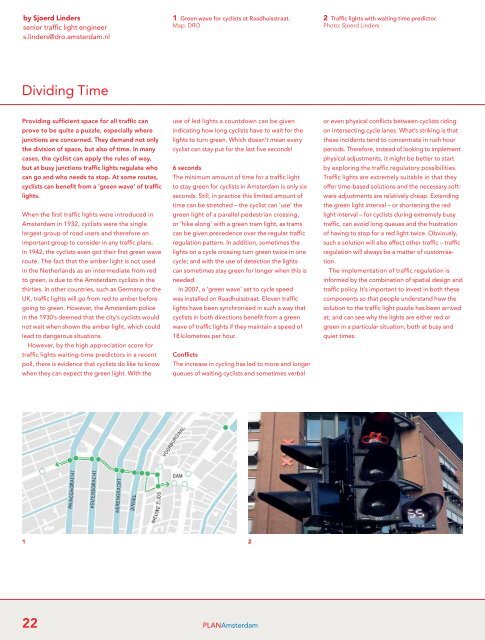PlanAmsterdam-Cycling-policy-and-design-PDF-2MB
PlanAmsterdam-Cycling-policy-and-design-PDF-2MB
PlanAmsterdam-Cycling-policy-and-design-PDF-2MB
You also want an ePaper? Increase the reach of your titles
YUMPU automatically turns print PDFs into web optimized ePapers that Google loves.
y Sjoerd Linders<br />
senior traffic light engineer<br />
s.linders@dro.amsterdam.nl<br />
1 Green wave for cyclists at Raadhuisstraat.<br />
Map: DRO<br />
2 Traffic lights with waiting time predictor.<br />
Photo: Sjoerd Linders<br />
Dividing Time<br />
Providing sufficient space for all traffic can<br />
prove to be quite a puzzle, especially where<br />
junctions are concerned. They dem<strong>and</strong> not only<br />
the division of space, but also of time. In many<br />
cases, the cyclist can apply the rules of way,<br />
but at busy junctions traffic lights regulate who<br />
can go <strong>and</strong> who needs to stop. At some routes,<br />
cyclists can benefit from a ‘green wave’ of traffic<br />
lights.<br />
When the first traffic lights were introduced in<br />
Amsterdam in 1932, cyclists were the single<br />
largest group of road users <strong>and</strong> therefore an<br />
important group to consider in any traffic plans.<br />
In 1942, the cyclists even got their first green wave<br />
route. The fact that the amber light is not used<br />
in the Netherl<strong>and</strong>s as an intermediate from red<br />
to green, is due to the Amsterdam cyclists in the<br />
thirties. In other countries, such as Germany or the<br />
UK, traffic lights will go from red to amber before<br />
going to green. However, the Amsterdam police<br />
in the 1930’s deemed that the city’s cyclists would<br />
not wait when shown the amber light, which could<br />
lead to dangerous situations.<br />
However, by the high appreciation score for<br />
traffic lights waiting-time predictors in a recent<br />
poll, there is evidence that cyclists do like to know<br />
when they can expect the green light. With the<br />
use of led lights a countdown can be given<br />
indicating how long cyclists have to wait for the<br />
lights to turn green. Which doesn’t mean every<br />
cyclist can stay put for the last five seconds!<br />
6 seconds<br />
The minimum amount of time for a traffic light<br />
to stay green for cyclists in Amsterdam is only six<br />
seconds. Still, in practice this limited amount of<br />
time can be stretched – the cyclist can ‘use’ the<br />
green light of a parallel pedestrian crossing,<br />
or ‘hike along’ with a green tram light, as trams<br />
can be given precedence over the regular traffic<br />
regulation pattern. In addition, sometimes the<br />
lights on a cycle crossing turn green twice in one<br />
cycle; <strong>and</strong> with the use of detection the lights<br />
can sometimes stay green for longer when this is<br />
needed.<br />
In 2007, a ‘green wave’ set to cycle speed<br />
was installed on Raadhuisstraat. Eleven traffic<br />
lights have been synchronised in such a way that<br />
cyclists in both directions benefit from a green<br />
wave of traffic lights if they maintain a speed of<br />
18 kilometres per hour.<br />
Conflicts<br />
The increase in cycling has led to more <strong>and</strong> longer<br />
queues of waiting cyclists <strong>and</strong> sometimes verbal<br />
or even physical conflicts between cyclists riding<br />
on intersecting cycle lanes. What’s striking is that<br />
these incidents tend to concentrate in rush hour<br />
periods. Therefore, instead of looking to implement<br />
physical adjustments, it might be better to start<br />
by exploring the traffic regulatory possibilities.<br />
Traffic lights are extremely suitable in that they<br />
offer time-based solutions <strong>and</strong> the necessary software<br />
adjustments are relatively cheap. Extending<br />
the green light interval – or shortening the red<br />
light interval – for cyclists during extremely busy<br />
traffic, can avoid long queues <strong>and</strong> the frustration<br />
of having to stop for a red light twice. Obviously,<br />
such a solution will also affect other traffic – traffic<br />
regulation will always be a matter of customisation.<br />
The implementation of traffic regulation is<br />
informed by the combination of spatial <strong>design</strong> <strong>and</strong><br />
traffic <strong>policy</strong>. It’s important to invest in both these<br />
components so that people underst<strong>and</strong> how the<br />
solution to the traffic light puzzle has been arrived<br />
at, <strong>and</strong> can see why the lights are either red or<br />
green in a particular situation, both at busy <strong>and</strong><br />
quiet times.<br />
1 2<br />
22<br />
PLANAmsterdam


